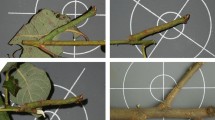Abstract
Taps were recorded from 46 male and 30 female deathwatch beetles, Xestobium rufovillosum.Beetles tap by striking the frons of the head on the substrate 4–11 times, at a frequency of about 11 Hz. There were no significant differences between the sexes in the number of strikes per tap, or in the frequency of the strikes, although there was significant variation between individuals of both sexes in both of these parameters. Males usually initiate a sequence of taps, to which females reply. Females responded more readily to male beetle taps containing high strike numbers. Use of an artificial tapper showed that females responded most to taps containing at least six strikes. Females did not discriminate between male beetle taps on the basis of strike frequency, although at abnormally high (20-Hz) or low (4-Hz) frequencies produced by the artificial tapper, females were less likely to respond. Male beetles located the source of taps from the artificial tapper and did this more readily with taps of a high strike number. It is not clear why some males produce taps with fewer than six strikes, as these are unlikely to elicit a female response, and so should be the subject of adverse sexual selection.
Similar content being viewed by others
References
Barr, B. A. (1969). Sound production in Scotylidae (Coleoptera) with emphasis on the genusIps. Can. Entomol. 101:636–637.
Birch, M. C., and Keenlyside, J. J. (1991). Tapping behavior is a rhythmic communication in the deathwatch beetle,Xestobium rufovillosum (Coleoptera: Anobiidae).J. Insect Behav. 4: 257–263.
Birch, M. C., and Menendez, G. (1991). Knocking on wood for a mate.New Sci. 1776: 42–44.
Birch, M. C., and White, P. R. (1988). Responses of flying maleAnobium punctatum (Coleoptera: Anobiidae) to female sex pheromone in a wind-tunnel.J. Insect Behav. 1: 111–115.
Crowson, R. A. (1981).The Biology of the Coleoptera, Academic Press, London.
Cymorek, S. (1960). Über das Paarungsverhalten und zur Biologie des HolzschäsingsPtilinus pectinicornis L. (Coleoptera: Anobiidae). XI International Kongress Für Entomologie, Wien.Verhandlangen 2: 335–339.
Fisher, R. C. (1937). Studies of the biology of the death-watch beetle,Xestobium rufovillosum De G. I. A summary of past work and a brief account of the developmental stages.Ann. Appl. Biol. 24: 600–613.
Fisher, R. C. (1938). Studies of the biology of the death-watch beetle,Xestobium rufovillosum De G. II. The habits of the adult with special reference to the factors affecting oviposition.Ann. Appl. Biol. 25: 155–180.
Goulson, D., Birch, M. C., and Wyatt, T. D. (1993a). Mate location in the deathwatch beetle,Xestobium rufovillosum De Geer (Anobiidae): Orientation to substrate vibrations.Anim. Behav. (in press).
Goulson, D., Birch, M. C., and Wyatt, T. D. (1993b). Paternal investment in relation to size in the deathwatch beetle,Xestobium rufovillosum (Coleoptera: Anobiidae), and evidence for female selection for large mates.J. Insect Behav. 6: 539–547.
Henry, C. S. (1980). The importance of low-frequency, substrate-borne sounds in lacewing communication (Neuroptera: Chrysopidae).Ann. Entomol. Soc. Am. 73: 617–621.
Hickin, N. E. (1963).The Insect Factor in Wood Decay, Hutchinson, London.
Howse, P. E. (1964). The significance of the sound produced by the termiteZootermopsis angus-ticollis (Hagen).Anim. Behav. 12: 284–300.
Ichikawa, T. (1976). Mutual communication by substrate vibrations in the mating behavior of planthoppers (Homoptera: Delphacidae).Appl. Entomol. Zool. 11: 8–21.
Ishay, J., and Schwarz, J. (1965). On the nature of the sounds produced within the nest of the Oriental HornetVespa oriental F.Ins. Soc. 12: 383–388.
Klassen, F. (1973). Stridulation and communication by substrate vibration inGeocarcinus lateralis (Crustacea: Decapoda).J. Comp. Physiol. 83: 73–79.
Klausnitzer, B. (1983).Beetles, Exeter Books, New York.
Levinson, H. Z., and Levinson, A. R. (1987). Pheromone biology of the tobacco beetle (Lasioderma serricorne F., Anobiidae) with notes on the pheromone antagonism between 4S,6S,7S-and 4S,6S,7R-serricornin.J. Appl. Entomol. 103: 217–240.
Lighten, J. R. B. (1987). Cost of tokking: The energetics of substrate communication in the tok-tok beetle, Psammodes striatus.J. Comp. Physiol. B 157: 11–20.
Mook, J. H., and Bruggemann, C. G. (1968). Acoustic communication byLipura lucens (Diptera: Chloropidae).Entomol. Exp. Appl. 11: 397–402.
Pearman, J. V. (1928). Sound production organ in the Psocoptera.Entomol. Mon. Mag. 64: 179–186.
Rovner, J. S., and Barth, F. G. (1981). Vibratory communication through living plants in the tropical wandering spider.Science 214: 464–465.
Rudinsky, J. A., and Michael, R. R. (1972). Sound production in Scolytidae: Chemostimulus of sonic signal by the Douglas-Fir beetle.Science 175: 1386–1390.
Stewart, K. W., and Maketon, M. (1990). Intraspecific variation and information content of drumming in three Plecoptera species. In Campbell, I. C. (ed.),Mayflies and Stoneflies, Kluwer Academic Publishers, London, pp. 259–268.
Tschinkel, W. R., and Doyen, J. T. (1976). Sound production by substratal tapping in beetles of the genusEusattus (Tentyriidae: Coniontini). Coleopt. Bull.30: 331–335.
Tumlinson, J. H. (1985). Beetles: Pheromonal chemists par excellence. In Hedin, P. A. (ed.),Bioregulators for Pest Control, ACS Symposium, Washington, DC, Series No. 276, pp. 367–380.
Wells, M. M., and Henry, C. S. (1992). Behavioral responses of green lacewings (Neuroptera, Chrysopidae, Chrysoperla) to synthetic mating songs.Anim. Behav. 44: 641–652.
White, P. R., and Birch, M. C. (1987). Female sex pheromone of the common furniture beetle,Anobium punctatum (Coleoptera: Anobiidae): Extraction, identification and bioassays.J. Chem. Ecol. 13: 1695–1706.
Wilcox, R. S. (1972). Communication by surface waves: Mating behavior of the water signal (Gerridae).J. Comp. Physiol. 80: 255–266.
Wilkins, J. (1668).An Essay Towards a Real Character and a Philosophical Language, Royal Society, London.
Zachariassen, K. E. (1976). Communication by sound between desert tenebrionids.Norw. J. Ento-mol. 24: 35–36.
Author information
Authors and Affiliations
Rights and permissions
About this article
Cite this article
White, P.R., Birch, M.C., Church, S. et al. Intraspecific variability in the tapping behavior of the deathwatch beetle,Xestobium rufovillosum (Coleoptera: Anobiidae). J Insect Behav 6, 549–562 (1993). https://doi.org/10.1007/BF01048122
Accepted:
Issue Date:
DOI: https://doi.org/10.1007/BF01048122




